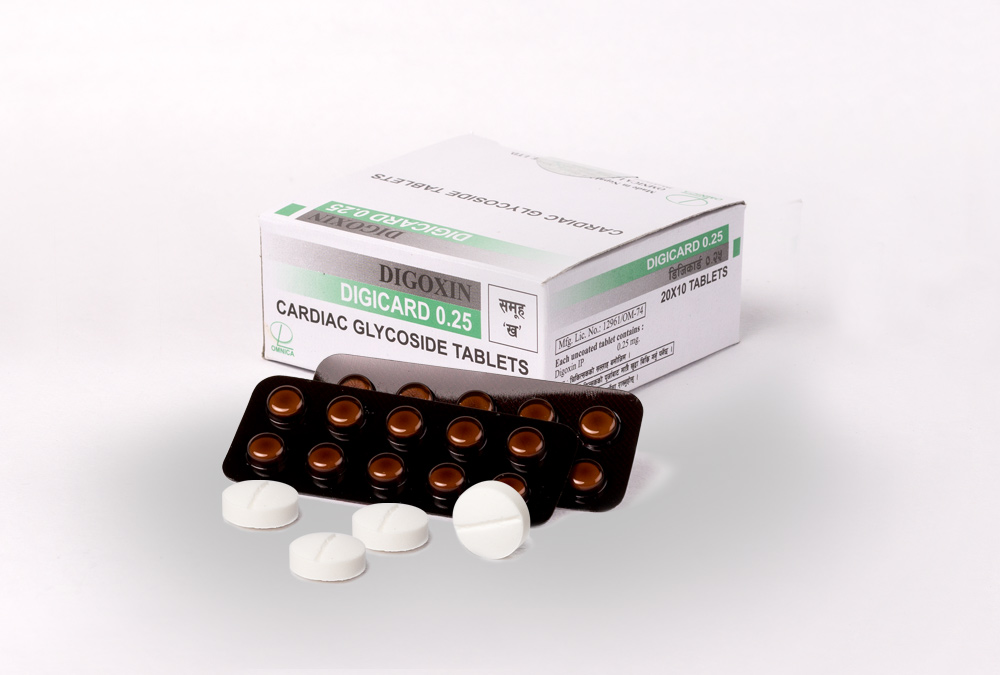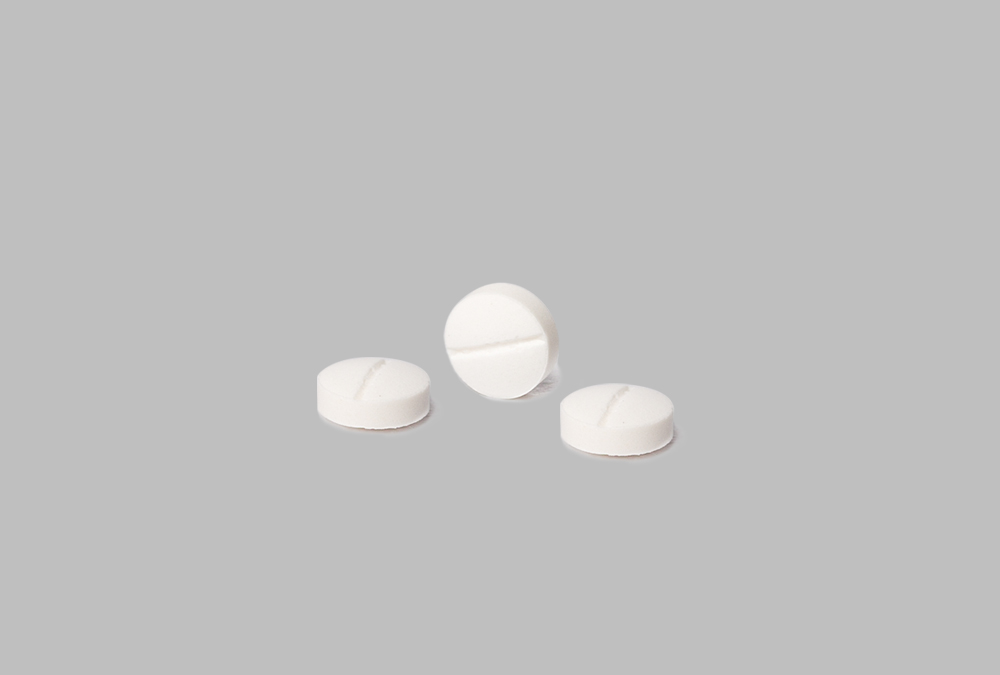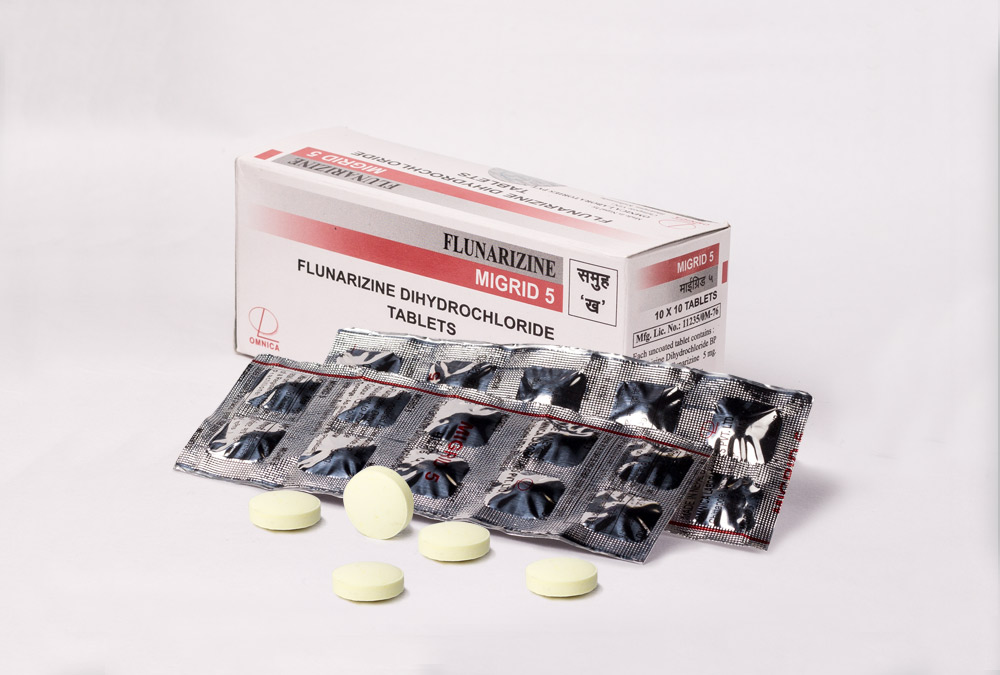Brand Name : DIGICARD
Generic Name : Digoxin
Preparation : 0.25 mg Scored Tablet
Pharmacological Category : Cardiac Glycoside
Mechanism of Action (MOA)
DIGICARD(Digoxin) inhibits Na+/K+-ATPase causing intracellular sodium concentration to increase. This then leads to an accumulation of intracellular calcium via the Na+-Ca++ exchange system. In the heart, increased intracellular calcium causes more calcium to be released by the sarcoplasmic reticulum, thereby making more calcium available to bind to troponin-C, which increases contractility (positive inotropic effect).
DIGICARD also increases vagal efferent activity to the heart with unknown mechanism. This parasympathomimetic action of digitalis reduces sinoartrial firing rate (decreases heart rate; negative chronotropic effect) and reduces conduction velocity of electrical impulses through the atrioventricular node (negative dromotropic effect)
Pharmacokinetics
- Absorption : 70% is absorbed from the gastrointestinal tract
- Distribution : Widely distributed in tissues including the heart, brain, erythrocytes and skeletal muscle, detected in CSF, breast milk and crosses the placenta
- Protein Binding : 20 to 30%
- Metabolism : Bacterial Flora in the gastrointestinal tract appear to be responsible
- Elimination Half-life : 1.5 to 2 days
- Excretion : Primarily renal
Indications and Dosage
Adult :
- Atrial Fibrillation
Rapid Digitalizing (loading-dose) Regimen
DIGICARD 10 to 15 mcg per kg total loading dose; administer 50% initially; then may cautiously give ¼ the loading dose every 6 to 8 hours twice; perform careful assessment of clinical response and toxicity before each dose
Maintenance
Half to one tablet of DIGICARD 0.5 mg per day; may increase dose every 2 weeks based on clinical response, serum drug levels, and toxicity - Heart Failure
As per ACCF / AHA guidelines, a loading dose to initiate digoxin therapy in patients with heart failure is not necessary.
Half to one tablet of DIGICARD 0.25 mg PO every day; higher doses including DIGICARD 0.375-0.5 mg per day is rarely needed.
Use lower end of dosing (DIGICARD 0.125 mg per day) in patients with impaired renal function or low lean body mass.
Side Effects
COMMON : Nausea, vomiting, anorexia, diarrhoea, abdominal pain, headache, facial pain, fatigue, weakness, dizziness, drowsiness, disorientation, mental confusion, bad dreams
RARE : Delirium, acute psychoses, hallucination, hypersensitivity
REPORTED : Convulsion, visual disturbance, blurred vision, thrombocytopenia, gynaecomastia
SERIOUS : Can aggravate heart failure at toxic doses (Supraventricular or ventricular arrhythmias and defects of conduction)
Contraindications
Hypertrophic obstructive cardiomyopathy, Wolff-Parkinson-White syndrome or other evidence of an accessory pathway, especially if it is accompanied by atrial fibrillation, ventricular arrhythmia, hypersensitivity to digoxin
Warnings / Precautions
- Cautiously used in partial heart block, sinus node disorders, acute myocarditis (rheumatic carditis), acute myocardial infarction, advanced heart failure, severe pulmonary disease.
- May enhance the occurrence of arrhythmias in patients undergoing cardioversion and should be withdrawn 1 to 2 days before such procedures if possible.
- Electrolyte imbalances and thyroid dysfunction may affect the sensitivity to digoxin.
- Effects of digoxin are enhanced by hypokalemia, hypomagnesaemia, hypercalcaemia, hypoxia and hypothyroidism.
- Resistance to the effects of digoxin may occur in hyperthyroidism.
- Should be given with care, and possibly in reduced dosage, to patients who have received it or other cardiac glycosides within the previous 2 or 3 weeks.
- Digoxin doses should generally be reduced and plasma-digoxin concentrations monitored in patients with renal impairment, in the elderly, and in premature infants.
Drug Interactions
- Digoxin with thiazides and loop diuretics cause hypokalaemia and also hypomagnesaemia and may lead to cardiac arrhythmias.
- Digoxin with corticosteroids, beta2 agonists (such as salbutamol), amphotericin B, sodium polystyrene sulfonate, carbenoxolone, and dialysis cause hypokalaemia.
- Intravenous use of calcium salts is best avoided in patients taking cardiac glycosides.
- Serum-digoxin concentrations may be significantly increased by quinidine, amiodarone, and propafenone and reduction of digoxin dosage may be required.
- Beta blockers may potentiate bradycardia due to digoxin.
- Calcium-channel blockers may increase digoxin concentrations
- Digoxin is a substrate of P-glycoprotein. Drugs that induce P-glycoprotein (eg. rifampicin) or inhibit P-glycoprotein (eg. verapamil) have the potential to alter digoxin pharmacokinetics.
Pregnancy Category : C
Presentation
DIGICARD 0.25 mg: A box of 20 blisters, each blister of 10 tablets







